Tiger salamander (Ambystoma tigrinum) Care Sheet
Common names: Tiger Salamander or Eastern Tiger Salamander
Scientific Name: Ambystoma tigrinum
Description
Description: Depending on the type of Tiger Salamander you have, their dorsum colours tend to range between olive green, grey and golden yellow. They have black, brown or grey blotches on their bodies, given them their tiger-like pattern and name.
Size: Tiger Salamanders generally grow to between 15 to 25cms (6-10inches) in length, but it is not unknown for them to reach 35cms (14inch) in some cases.
Life span: (Captive) Tiger Salamanders can live between 10 – 25 years with appropriate care.
Origin: Tiger salamanders are found throughout North America.
Habitat: The Tiger Salamander has two specific phases in it’s life cycle, which both determine the habitat that they are found in. The larvae are entirely aquatic, living in ponds and shallow lakes. Adults are terrestrial and only return to the water for breeding purposes. They can be found burrowing in grasslands and hiding in the undergrowth. They are hardly ever seen out in the open.
Things to consider when purchasing your first Amphibian
• Who will look after your new pet if you are away?
• Can you get food easily from your local pet shop?
• Can you deal with feeding live insects as food?
• Can you handle the live food to feed your pet?
• Is the rest of the family happy to live with an amphibian?
Captive Care
Temperament: Tiger salamanders are highly inquisitive and lively salamanders, and can often be seen exploring their tank. They make an ideal first amphibian as they are relatively easy to care for.
Housing: Adult Tiger salamanders are quite large and will require a larger terrarium than most ground dwelling amphibians. A 15-20 Gallon tank should be adequate for 2 adult salamanders. They are quite social and can be housed with other Tiger salamanders.
Tiger salamanders do well in a woodland set-up with deep coco husk substrate.
Larvae are entirely aquatic, so if you are housing a Tiger Salamander in the larval stage you will need an aquarium heated to around 19oC (67oF) with 15cm (6 inches) of water in the bottom. A filter, airstone and rocks to hide behind will also be necessary to ensure the health of your larvae.
Feeding
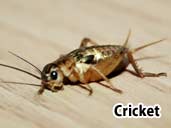 |
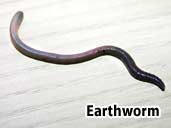 |
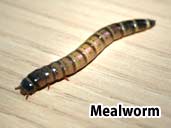 |
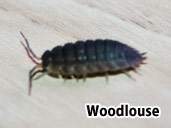 |
Salamanders should be fed daily with a varied diet of appropriately sized gut loaded insects, including meal worms, crickets, small grass hoppers, flour beetles, wax-worms, moths, caterpillars, earthworms, woodlice and may even take pinkie mice. Feeding 3 or 4 insects per salamander per feeding.
The live food should be dusted with calcium and vitamin supplements once a week.
As adults your Salamander should be able to feed on the occasional pinkie mouse, but you should regard this as a treat item as regular feedings on mice can cause your Salamander to become obese.
Tiger Salamanders will actively hunt their food, instead of waiting for it to come to them like other frogs and salamanders. This makes them enjoyable to watch at feeding time.
Cleaning
Your Tiger Salamander’s terrarium should be inspected and spot cleaned daily when changing the water. Every two to three weeks clean out the tank completely and sterilise using a reptile/amphibian friendly disinfectant. Sterilise any décor and carefully remove any live plants to replace when the tank has been cleaned. Your salamander(s) should be moved to a temporary tank whilst being cleaned.
Handling
All amphibians are delicate skinned and oils and salts on our skin can cause them harm. It is recommended to wear gloves if the need to handle arises.
Shedding
Tiger salamanders shed their skin at regular intervals as they grow. The old skin is pushed off with the hind legs and the skin peels off from the back end. The skin should come off in one piece and is normally eaten by the salamander. The skin is pushed forwards using it’s legs towards the mouth.
Sexing
Females tend to be larger than males, with males being more slender-bodied.
Your terrarium should contain:Substrate
A deep coco husk substrate as Tiger Salamanders like to burrow, sphagnum moss, peat, live moss and a selection of live plants (see plant list in the forum) can all be used in your set-up. Avoid using vermiculite and gravel as these are no good for burrowing. Set-up tips can also be found on the forum.
A place for your salamander to hide and climb
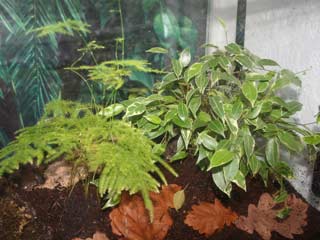 All amphibians require somewhere to hide and may become stressed if this is not provided. This could be a plant pot on its side, which is low cost but easily cleaned if it becomes soiled.
All amphibians require somewhere to hide and may become stressed if this is not provided. This could be a plant pot on its side, which is low cost but easily cleaned if it becomes soiled.
Logs and cork bark make good natural looking additions to your terrarium and make great hiding places. Plants and stones can also be used.
Stones or branches from the wild need to be debugged by soaking first in chlorine/water solution, then rinsed thoroughly, soaked in clean water, then left to dry in the sun.
Some live plants may be harmful to your salamander, if in doubt please see the list of safe plants which can be used on the 'Frequently Asked Questions' section or in the forum.
A change of scenery
Tiger salamanders are very inquisitive animals and like to explore new surroundings. Once in a while change the layout of the terrarium; this will keep your salamander from becoming bored. You will notice once you put your salamander(s) back in the tank it will start to re-explore its new surroundings.
Water
All amphibians need fresh water daily. A large water bowl should be given (no deeper than the salamanders height when at rest) with de-chlorinated or bottled spring water. The water should be changed daily to avoid the build up of bacteria.
Salamanders like most amphibians will soak up water through their skin and since their water bowl is used as the main place to defecate it is important that it is cleaned regularly.
Humidity
Misting the tank regularly with de-chlorinated or bottled spring water will ensure that the substrate does not dry out. Placing the water bowl in the warmer side of the terrarium will also raise humidity levels, although it is unlikely that your salamanders will need extra humidity. In the wild they live in quite dry grasslands, so keeping your substrate damp is all that is necessary.
Heat
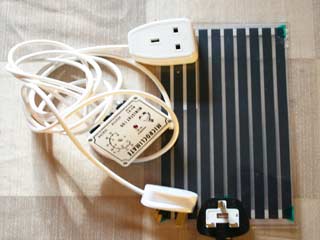 The ideal temperature for your salamander(s) is a temperature gradient of 18-21°C with a slight temperature drop at night or 2 or 3 degrees.
The ideal temperature for your salamander(s) is a temperature gradient of 18-21°C with a slight temperature drop at night or 2 or 3 degrees.
Additional heat should not be required for most of the year, but in winter, heat can be provided using a heat mat regulated with a thermostat. Heat mats should only cover between a third and a half of the floor or wall space to allow your salamander to thermo regulate. A cool hide should be placed in one end of the tank and a hotter hide at the warmer end, giving your salamanders a place to hide at both ends.
Never use heat lamps or basking lamps for amphibians, as these can cause your salamanders to dehydrate.
It's useful to have a small thermometer on either end of the terrarium to check the temperature.
Lighting
Tiger salamanders do not need the edition of UV lighting if they have enough vitamins and variation in their diet. Although you may find the live plants in your terrarium will die without any light. A fluorescent low UVB tube is ideal as it won’t give out any heat and will help the plants thrive. You should place the light at one side of the terrarium creating a light gradient so your salamanders can find a darker place out of the light if preferred. Ideally you should cycle the lighting to mimic the salamanders natural habitat by having a 12/12 system - 12 hours of light and 12 of dark.
Other questions about the Tiger salamander
This care sheet is a simple step-by-step guide to successful Tiger Salamander keeping, but if you have anymore questions or need more specific information about the keeping of Tiger Salamanders, please enter our forum. It is a useful resource where you can ask members to share good practice and also talk about your experiences of being a Tiger Salamander keeper.

